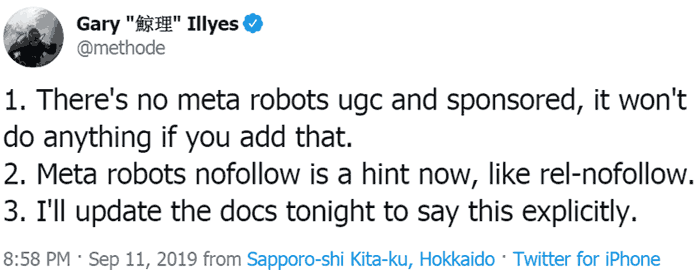11 Sep Google Will Now Treat Meta Robots Nofollow as a Hint via @martinibuster
Google Webmaster Trends Analyst Gary Illyes tweeted that Google is officially changing support for Meta Robots Nofollow. Google now treats the meta robots nofollow as a hint, similar to the behavior to the recently updated nofollow link attribute.
Note: The tag is alternately called Robots Meta and Meta Robots. This article, for consistency, follows how Gary Illyes referred to it, Meta Robots Nofollow.
What is Meta Robots Nofollow?
The Meta Robots Nofollow tag was a directive. A directive are instructions that Google’s crawler (robot) is obligated to obey.
The Meta Robots Nofollow was used to keep Google from crawling all links contained on a page.
Below is a screenshot of Google’s Meta Robots developer page showing that the Meta Robots Nofollow is considered a directive. This page will be updated to reflect that Google now treats it as a hint.


As of today, the Meta Robots Nofollow is no longer a directive. It will be treated as a hint. That means that Google may or may not obey the Meta Robots Nofollow when it encounters it.
Meta Robots Nofollow Tag is a Hint
Gary Illyes tweeted that the Meta Robots Nofollow tag is now just a hint.
Here is Gary’s announcement:
“1. There’s no meta robots ugc and sponsored, it won’t do anything if you add that.
2. Meta robots nofollow is a hint now, like rel-nofollow.
3. I’ll update the docs tonight to say this explicitly.”
Does This Change Actually Change Anything?
There are few situations where a publisher would want to use a meta robots nofollow tag. Previously, publishers used to use the Meta Robots Noindex together with the Nofollow.
But that was redundant. Google couldn’t follow a link if it was prohibited from crawling the page.
And if the page is a Pay Per Click (PPC) landing page, a publisher only needs to use the robots noindex to keep the landing page from being indexed.
Was the Meta Robots Nofollow Redundant?
The net effect of using the meta robots nofollow was to create a page that could be indexed but that effectively contained no outbound links.
That makes a nofollow page a dead end in terms of crawling. The crawler has nowhere to go.
That’s not a good situation for a publisher because it’s a good practice to keep Google’s crawler moving through a website, not to stop it at every turn.
I’m sure someone has a good use for the Meta Robots Nofollow. But it kind of feels like it was somewhat of little use because it was redundantly used together with the robots meta noindex.
Read:Gary Illyes announcement on Twitter

Sorry, the comment form is closed at this time.